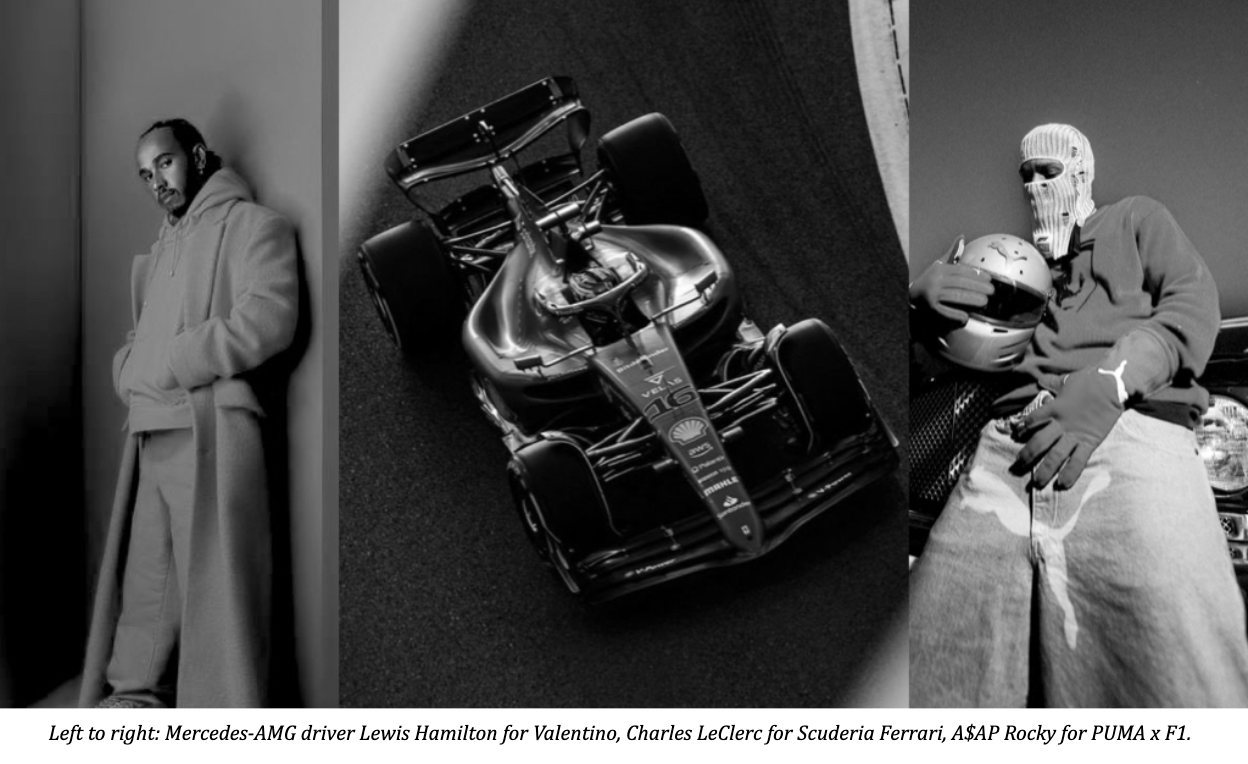Executive summary:
At the intersection of performance, celebrity, and entertainment, Formula 1 is making a groundbreaking rise in American pop culture. Audiences seeking its high-octane action are turning their gaze to the roaring engines of race day in record-breaking numbers. While the Euro-born motorsport has always proven an obvious platform for elite brands, the overnight success of F1 in the US suggests a widespread embrace of the wealthy and aspirational lifestyle celebrated by the sport, distinguishing Formula 1 as a powerful new vehicle for luxury brands to connect with the American mainstream.
While the FIA, Formula 1’s official governing body, dates back to 1904, the “new age” of F1 came in 2016 when Colorado-based Liberty Media Corporation acquired Formula 1 Group for a cool $4.6Billion. Grappling with steep declines in viewership and dwindling international appeal, the once revered sport found itself on the road to obsolescence. But American mass media mogul LMC, known for its diverse portfolio in sports and entertainment, still saw extreme potential in the Formula 1 enterprise. Their strategic pivot to create spectacle beyond the racetrack - highlighting drama and emotionality while activating modern content streams like Instagram, X, YouTube, and Netflix - would effectively endear the drivers and their revamped narratives to a younger, digital native audience, while tactfully weaving F1 into the fabric of American pop culture.
In 2023, Formula 1 shattered US viewership records through eight of their 23 international grands prix. The record-setting season, which included the highly anticipated introduction of the Las Vegas Grand Prix, secured Liberty Media a fresh $85Million per year US broadcasting extension with ESPN to eclipse their $5Million contract from the year prior. Business F1 Magazine reports that tech giant Apple now eyes worldwide broadcasting rights at a price tag of $2Billion per year to begin in 2025. And Forbes has lauded Formula 1 as “the most valuable sports empire in the world” at $17.1Billion under its new stewardship.
Yet, Formula 1's influence extends far beyond the realm of sports. It has become a cultural phenomenon, where the boundaries between athlete-celebrity and luxury brands seamlessly blur. Beyond official team partners like Richard Mille for Scuderia Ferrari, Tag Heuer for Red Bull Racing, or IWC Schaffhausen for Mercedes-AMG, collaborations between luxury brands and drivers have extended off-grid to redefine pop culture with Formula 1 at its center. Seven-time world champion Lewis Hamilton has established himself as a cultural icon on and off the track, starring in collections for Valentino alongside Zendaya and designing his own line for Hilfiger. This year’s New York, Paris, and Milan fashion weeks glistened with cameos from drivers Pierre Gasly at Louis Vuitton, Esteban Ocon at Givenchy, and crowd favorite Charles LeClerc sitting front row at Nahmias. Racing team Scuderia AlphaTauri even debuted a custom collection alongside their latest car design. Ferrari Creative Director Rocco Iannone is excited by this cultural expansion, seeing luxury fashion as a “natural extension” of Formula 1’s lifestyle and brand.

Equally so, brands have identified Formula 1’s star-studded grand prix as the ideal runway for their thrilling, high-visibility collaborations. This year’s Las Vegas Grand Prix served as the backdrop for PUMA’s new appointment of Grammy-nominated music and fashion icon A$AP Rocky as their creative director for the PUMA x F1 partnership. The announcement came just months after PUMA and Formula 1 inked a long-term agreement granting PUMA exclusive licensee and trackside retailer rights for the Formula 1 name. Rocky premiered a limited edition PUMA x F1 capsule in Las Vegas and will focus on designs and marketing efforts surrounding several grands prix in 2024, with full brand immersion by 2025. PUMA’s disruptive decision to merge the worlds of legacy motorsport and streetwear came with the confidence that Rocky’s vision will bring a fresh perspective to F1’s growing audience and continue to push the sport forward. While Rocky remarked that working with brands as iconic as PUMA and as innovative as F1 has inspired him for the future. “When the world sees what we’re doing, I believe a shift will happen with how brands approach taking risks and working with diverse creatives.” The partnership marked one of several show-stopping drops in Las Vegas, including Mitchell & Ness x McLaren, Sacai x Mercedes, and Takashi Murakami x Lewis Hamilton.
Looking ahead, major brands are racing to stake their claim in Formula 1’s growing American presence. Audi is confirmed to join the grid in 2026, and the all-American Andretti Formula Racing team remains the top contender for the next open spot in the paddock. A collaboration between former world champion Mario Andretti and General Motors, the outfit powered by Cadillac offers a competitive package with good brand visibility. “The presence of iconic American brands is good for the sport,” says FIA president Mohammed Ben Sulyamen. While Andretti believes they are not asking F1 for any favors. “We’re bringing something to the party.” Beyond this, F1 CEO Stefano Domenicali continues to tease the possibility of adding a fourth US Grand Prix to the existing Austin, Miami, and Las Vegas circuits, presenting a range of high-profile opportunities for future brand partners, while further enmeshing Formula 1 in the DNA of American culture.
Formula 1's unprecedented rise in the US is a testament to the transformative power of strategic and innovative marketing. Its rapidly growing influence and genre-bending collaborations showcase an expanding footprint in the world of pop culture, while its mission to excite and disrupt converts young viewers to an ever-growing fanbase. Furthermore, Formula 1's trajectory signals a dynamic shift in mass appeal for high-performance luxury goods, while offering a conduit for elite brands to speak to the heart of the American mainstream.
And while we now hold the keys to the machine, one question remains like the smell of burnt rubber:
Who will turn the ignition?
References: